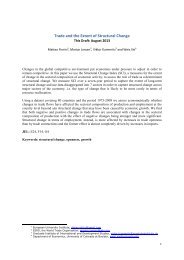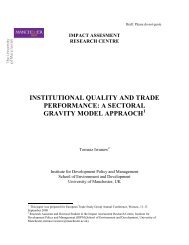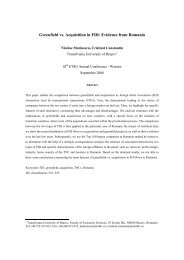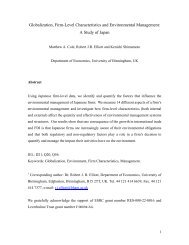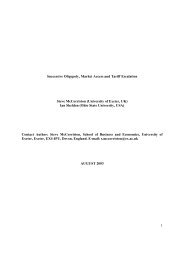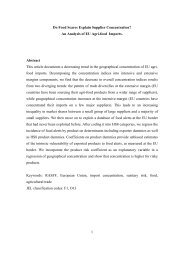Regional integration and the other determinants of North-South ...
Regional integration and the other determinants of North-South ...
Regional integration and the other determinants of North-South ...
You also want an ePaper? Increase the reach of your titles
YUMPU automatically turns print PDFs into web optimized ePapers that Google loves.
all <strong>the</strong> countries is <strong>the</strong> same as <strong>the</strong> distribution <strong>of</strong> <strong>the</strong> whole industry across countries. In this<br />
case <strong>and</strong> are high. Specialization indexes compare <strong>the</strong> share <strong>of</strong> each industry (i) in<br />
country’ (c) industrial production to <strong>the</strong> share <strong>of</strong> each industry in <strong>the</strong> total production in <strong>the</strong><br />
area. The higher <strong>and</strong> , <strong>the</strong> more specialized <strong>the</strong> countries are. Note that specialization<br />
<strong>and</strong> concentration levels depend on <strong>the</strong> overall distribution <strong>of</strong> production in <strong>the</strong> sample.<br />
Table 2.2 gives <strong>the</strong> Theil <strong>and</strong> dissimilarity specialization indexes for each country 18 .<br />
With <strong>the</strong> exception <strong>of</strong> Irel<strong>and</strong> <strong>and</strong> Finl<strong>and</strong> 19 <strong>and</strong> Greece, WEC appear less specialized than<br />
NMS <strong>and</strong> MC. Malta, Tunisia, Cyprus <strong>and</strong> Latvia are <strong>the</strong> most specialized countries (on<br />
average) in <strong>the</strong> period studied. Conversely, <strong>the</strong> UK, Germany, France <strong>and</strong> Spain are <strong>the</strong> most<br />
diversified countries <strong>of</strong> <strong>the</strong> area. The significant specialization level <strong>of</strong> Malta is essentially<br />
due to significant production in high-technology industries, <strong>and</strong> in particular in electric<br />
machinery 20 . On <strong>the</strong> contrary, <strong>the</strong> high specialization level in Tunisia is related to a substantial<br />
production in low-technology industries (footwear <strong>and</strong> lea<strong>the</strong>r products industries). Cyprus,<br />
Latvia <strong>and</strong> Lithuania are also specialized in low-technology industries. In Cyprus, an<br />
important part <strong>of</strong> <strong>the</strong> national production takes place in food products (30% <strong>of</strong> <strong>the</strong> country’s<br />
total industrial production) <strong>and</strong> o<strong>the</strong>r non-metallic mineral products (12%) 21 . Latvia <strong>and</strong><br />
Lithuania are both specialized in wood products <strong>and</strong> wearing apparel products. These<br />
industries constitute respectively 24 % <strong>and</strong> 3% <strong>of</strong> Latvia’s industrial production <strong>and</strong> 9% <strong>and</strong><br />
10 % <strong>of</strong> Lithuania’s industrial production 22 .<br />
[Table 2.2]<br />
Even if Western European countries are relatively diversified, <strong>the</strong> level <strong>of</strong><br />
specialization (in high-technology industries) increased in most <strong>of</strong> <strong>the</strong>se countries between<br />
1990 <strong>and</strong> 2003. The Theil index significantly increased in France 23 <strong>and</strong> <strong>the</strong> UK whereas it<br />
decreased in Portugal (-10%), Belgium/Luxembourg (-10%) <strong>and</strong> Sweden (-4%). In Portugal,<br />
<strong>the</strong> share <strong>of</strong> some low-technology industries in to total production has decreased (about -60%<br />
in tobacco <strong>and</strong> lea<strong>the</strong>r products industries) in favor <strong>of</strong> high-technology sectors (pr<strong>of</strong>essional<br />
<strong>and</strong> scientific equipment, 67%). Considering new member states, Hungary, Latvia <strong>and</strong> Cyprus<br />
are <strong>the</strong> most specialized. Only five <strong>of</strong> <strong>the</strong> ten new member states became more specialized in<br />
2003. This increase in <strong>the</strong> Theil index is particularly significant for Latvia (112%) 24 , Romania<br />
(95 %) <strong>and</strong> Bulgaria (30%). On <strong>the</strong> contrary, Estonia, Lithuania <strong>and</strong> Pol<strong>and</strong> show a dramatic<br />
decrease <strong>of</strong> <strong>the</strong>ir Theil index. Finally, one can note that Tunisia, Egypt <strong>and</strong> Morocco are <strong>the</strong><br />
most specialized Mediterranean countries. The specialization level significantly increased in<br />
18 Note that results <strong>of</strong> both indexes are quite similar.<br />
19 Irel<strong>and</strong> is relatively specialized in industrial chemicals industry <strong>and</strong> Finl<strong>and</strong> is specialized in paper <strong>and</strong><br />
products.<br />
20 Note that considering <strong>the</strong> location quotient (see appendix A.1), a country is specialized if <strong>the</strong> part <strong>of</strong> a industry<br />
in <strong>the</strong> country’s total industrial production is significant relatively to <strong>the</strong> importance <strong>of</strong> this industry in <strong>the</strong><br />
industrial production in <strong>the</strong> area.<br />
21 As food products industry constitutes a large part <strong>of</strong> <strong>the</strong> area industrial production, Cyprus appears relatively<br />
more specialized in o<strong>the</strong>r non-metallic mineral products.<br />
22 As in Cyprus, food products constitute a significant part <strong>of</strong> Latvia <strong>and</strong> Lithuania’s industrial production.<br />
However, because <strong>of</strong> <strong>the</strong> significant level <strong>of</strong> production in this industry in <strong>the</strong> Euro-Mediterranean area, <strong>the</strong><br />
relative specialization <strong>of</strong> this to countries in food products remains moderated.<br />
23 The increasing specialization in France is partly due to a significant increase <strong>of</strong> <strong>the</strong> location <strong>of</strong> <strong>the</strong> transport<br />
equipment industry in France. This industry represented 14% <strong>of</strong> <strong>the</strong> French industrial production in 1990 <strong>and</strong><br />
28% in 2003. It is also related to <strong>the</strong> significant decrease in <strong>the</strong> location <strong>of</strong> some low <strong>and</strong> medium technology<br />
sector in France between 1990 <strong>and</strong> 2003 (printing <strong>and</strong> publishing, footwear <strong>and</strong> o<strong>the</strong>r manufactured products).<br />
24 Latvia appears increasingly specialized in wood products <strong>and</strong> iron <strong>and</strong> steel industry. In 2003, <strong>the</strong>se industries<br />
represented respectively 24% (2% in 1990) <strong>and</strong> 6 % (1% in 1990) <strong>of</strong> <strong>the</strong> Latvia’s industrial production.<br />
7



